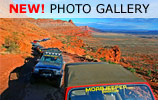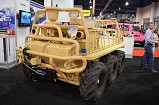 |
||
| > Reader's Photo OX5 by Lockheed Martin |
||
| • ADVERTISE WITH US | ||
| • WHO IS MOAB JEEPER? | ||
Home > Jeep Articles > Technical & Installation - Body Interior / Exterior > HAUL-MASTER Cargo Carrier |
||||||||||||||||||||||||||||||||||||||||||||||
 |
||||||||||||||||||||||||||||||||||||||||||||||
|
HAUL-MASTER Cargo CarrierArticle written by Moab ManDate Added: 08/03/2008 If you own a traditional Jeep, you know space is at a premium. |
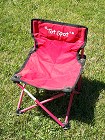
|
 Knowing this, our first thought when purchasing any camping gear is ?How will we fit it in the Jeep?? Think I?m kidding? We even carry little kiddie-style folding camping chairs since we can?t afford to give up the room for adult sized chairs. Knowing this, our first thought when purchasing any camping gear is ?How will we fit it in the Jeep?? Think I?m kidding? We even carry little kiddie-style folding camping chairs since we can?t afford to give up the room for adult sized chairs.Fortunately, we are about to step-up to the good life with the addition of our HAUL-MASTER 500 lb. Aluminum Cargo Carrier (Harbor Freight Model: 92655). Follow along as we assemble the carrier and review it. |
||||||||||
|
Installation | |||||||||||

|
1. Slide the Steel Tube (3) through the carrier. Then slide the Steel Tube with carrier into your vehicle?s hitch receiver. Insert Pin (12) to lock it all to your vehicle. |
||||||||||
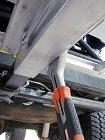
|
2. With the carrier off the ground, making it much easier to work on, secure the Cargo Carrier to the Steel Tube using the two included long bolts (Bolt M10 x 75), lock washers (Spring Washer M10), flat washers (Washer M10), and nuts (Nut M10).  Ours was missing the flat washers. Ours was missing the flat washers. |
||||||||||

|
3. Next we need the butt-load of Phillips head bolts (6) and Nylock nuts (7). |
||||||||||

|
4. Attach the front and rear Large Supports (4), corner Reflector supports (14), and two Small Vertical Supports (5). Do not tighten down the bolts on the supports yet. |
||||||||||

|
5. Lower the Top Brace (1) onto the upright supports. Loosely bolt the uprights to the Top Brace. |
||||||||||

|
6. Bolt in the rest of the supports. We cheated and used the air tools to make quick work of the 40 support bolts. We strongly suggest you do the same. |
||||||||||

|
7. Here it is all assembled. |
||||||||||

|
8. The CLAIMED dimensions are 49? x 22.5? x 8? with an inside height of 7?. Since all that really matters is the inside dimension, the ACTUAL length & width came out to 47? x 20.5?. Most curious is the inside height. It seems that coming through Customs from China, the carrier seemed to lose and additional inch. We measured the inside height at 6?. |
||||||||||

|
9. We liked the reflectors at the corners. These should help to catch the attention of those less attentive drivers. |
||||||||||

|
10. The basic construction of the carrier is with pop-rivets. |
||||||||||

|
11. We chose to assemble our carrier with the bolts facing out. This was done to avoid ripping or puncturing our cargo. Sure we will catch some leg skin from time to time, but we?ll heal. |
||||||||||
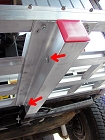
|
Installation IssuesThe holes through the carrier securing it to the Steel Tube should have been drilled to a much tighter tolerance. There is, in our opinion, unnecessary slop allowing the carrier to lean left and right. We would NEVER recommend altering a product, but we intend to tighten this up with larger bolts that will better match the holes in the Steel Tube. To do this, the product will need modifying; but we?ll leave it up to you to figure out how. We plan to use one of those twisty things that go in a drill. |
||||||||||

|
Final ThoughtsWhy this cargo carrier? There are plenty of options out there, and some are quite pricey. We chose this one for its 500lb capacity, aluminum construction, and the fact it doesn?t weigh very much (we weighed ours at 26lbs).Overall, we're very satisfied with the product. It's built to handle loads far heavier than we will ever use it for, it's deep enough to keep its contents in place, and being tucked behind the Jeep were not adding any wind drag (gas is over $4 so it matters) as overhead carriers do. Safety The Cargo Carrier is rated for 500lbs, but before you go out there and start loading up you need to understand a few things about your vehicle and its receiver. What "Class" receiver do you have? If you don?t know, and it?s not listed on your receiver, it all becomes clear as mud? very thick mud. Common wisdom, although wisdom is not the right word, is that if it has the smaller 1? receiver then it is a Class 1. This is NOT necessarily true. In our research we found there are some Class 1 receivers set at 2 inches, so file that ?common wisdom? in the appropriate place. Once you figure out what Class of receiver your vehicle is equipped with, you need to know how much tongue weight it can carry. Sure the carrier can handle 500lbs, but if the receiver on your vehicle is only rated for (Class 1) 200lbs you?re limited to loads no greater than 200lbs. This brings us to DYNAMIC LOADING. What the heck is that? Stand on a scale and bounce, really, go do it. It doesn?t take much to cause your reflected weight to increase substantially for a brief moment. This bouncing of your weight is dynamic loading. All we can say is when loading your cargo carrier, be mindful of the terrain you plan to cross. The weight I load in this carrier for road travel will be quite different than it will be if I?m heading through bouncy rocky trails of the Rocky Mountains looking for a camp site. The short version of all this is: Keep the heavy stuff in the Jeep, and pack the lighter, bulkier stuff on the cargo carrier. And the best part for me personally? I can bring my full sized chair. |
||||||||||
Purchase / Vendor Info
|
| Vendor Name: | Harbor Freight |
| Address: | 3491 Mission Oaks Blvd Camarillo, CA 93011 |
| Phone: | 800-423-2567 |
| E-Mail Address: | |
| Website: | http://www.harborfreight.com/ |
